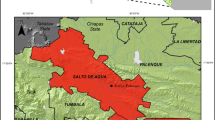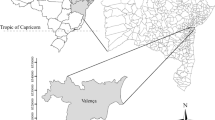Abstract
The purpose of natural fallow in bush-fallow cultivaton systems is to improve soil fertility following a phase of cultivation and to provide useful forest products, including livestock feed. When natural fallow fails to serve these purposes, it can be supplemented or replaced by planted trees. This paper describes the development and function ofAcacia fallow in the Soli tribal land of central Zambia and examines the supplementary role of planted trees.
The 31 woody species at five fallow sample sites were dominated byAcacia polyacantha. Thirty-nine percent of the species are leguminous and N-fixing while 42% are fodder plants. These species make thisAcacia fallow suitable for regeneration of soil fertility and production of fodder. The dominant species,A. polyacantha, has an extensive lateral root system and may attain a mean maximum girth at breast height (BH) of 125 cm within 20 years. In the study areaAcacia fallow regenerates from seed and root-stocks and with a maximum annual stem basal area increment of 0.87 m2ha−1 at BH can acumulate a total of 17.4 m2ha−1 in 20 years.
However,Acacia fallow is poor in edible wild fruits and durable construction wood. The scarcity of fruits in the study area has been compensated by widespread planting of exotic fruit trees. Ninety percent of households have fruit trees (mean 2.3 fruit species per household). However, in spite of the scarcity of good construction wood in the Soli tribal land, no local initiative has developed to plant timber trees. A clear opportunity therefore exists to promote timber tree planting. Such a tree planting programme was started in the study area during the 1985/86 planting season (December-February) when 25,100 seedlings ofEcualyptus grandis, Gmelina arborea andLeuceana leucocephala were distributed, free of charge and the programme will continue until 1988. A survey carried out five to seven months after planting revealed that the survival ofE. grandis, L. leucocephala andG. arborea seedlings was 65%, 90% and 92%, respectively. The high mortality ofE. grandis seedlings was due to termite damage.
Similar content being viewed by others
References
Trapnell CG (1953) The soils, vegetation and agriculture of North-eastern Rhodesia. Goovernment Printer, Lusaka
Trapnell CG and Clothier JN (1957) The soils, vegetation and agricultural systems of North-western Rhodesia. Government Printer, Lusaka
Stromgaard P (1984) Field studies of land use under chitemene shifting cultivation, Zambia. Geografisk Tidsskrift 84: 78–85
Stromgaard P (1985) A subsistence society under pressure: The Bemba of Northern Zambia. Africa 55(1), 39–59
Chidumayo EN (1987) A shifting cultivation land use system under population pressure in Zambia. Agroforestry Systems 5: 15–25
Prinz D (1986) Increasing the productivity of smallholder farming systems by introduction of planted fallows. Plant Research and Development 24: 31–56
Government of Zambia and International Union for Conservation of Nature and Natural Resources (1985) The national conservation strategy for Zambia. IUCN, Gland
Chidumayo EN (1984) Woodfuel issues. Paper prepared for the first technical seminar for the national conservation strategy for Zambia, May 1984, Lusaka
Bohlin F and Larsson G (1983) Village tree planting study carried out for IRDP, Eastern Province, Zambia. Swedish University of Agricultural Sciences, Uppsala
White F (1962) Forest flora of Northern Rhodesia. Oxford University Press, Oxford
Pullan RA (1974) Farmed parkland in Zambia. Zambia Geographical Association Magazine 26: 1–17
Storrs AEG (1982) More about trees: A sequel to know your trees. Forest Department, Ndola
Högberg P (1986) Nitrogen-fixation and nutrient relations in savanna woodland trees (Tanzania). Journal of Applied Ecology 23: 675–688
Du Toit RF, Campbell BM, Hanney RA and Dore D (1984) Wood usage and tree planting in Zimbabwe's communal lands. Forestry Commission of Zimbabwe and World Bank, Harare
Edmonds ACR (1964-65) Forest management book for Lusaka and Feira districts. Forest Department, Ndola
Chidumayo EN (1987) Woodland structure, destruction and conservation in the copperbelt area of Zambia. Biological Conservation 40: 89–100
Högberg P and Kvarnström M (1982) Nitrogen fixation by the woody legumeLeuceana leucocephala in Tanzania. Plant and Soil 66: 21–28
Author information
Authors and Affiliations
Rights and permissions
About this article
Cite this article
Chidumayo, E.N. Integration and role of planted trees in a bush-fallow cultivation system in central Zambia. Agroforest Syst 7, 63–76 (1988). https://doi.org/10.1007/BF01890470
Issue Date:
DOI: https://doi.org/10.1007/BF01890470




